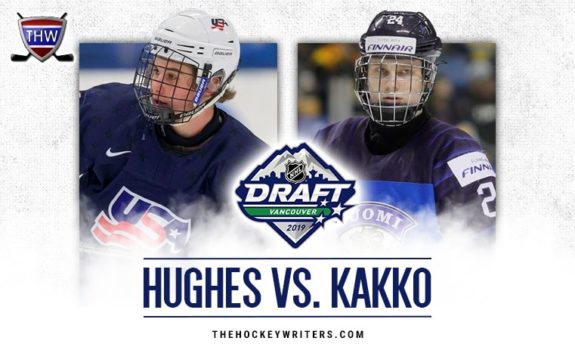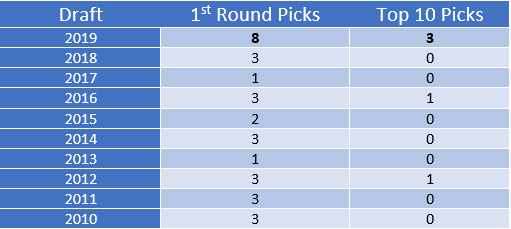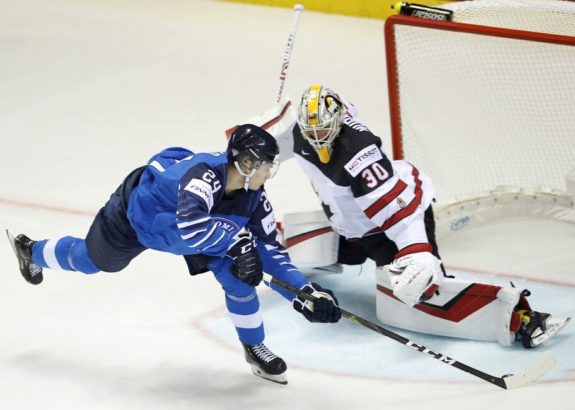The headlines leading up to the 2019 NHL Draft in Vancouver were focused on the top two ranked prospects, American Jack Hughes and Finnish star Kappo Kakko. While these players have very different attributes as top NHL prospects, they are very similar in how they developed into potential stars. Both have played with and against older players over the last two seasons.

While both players commanded most of the media attention on day one of the draft, the bigger story over the full seven rounds was the impressive number of picks selected from the US National Team Development Program (USNTDP). A total of 17 players from the USNTDP’s Under-18 (U-18) team were chosen from a roster of 24 players (70%) that played during the 2018-19 season. That is the most players selected from one team in one draft in NHL history. The previous record was 13 players chosen from both the 2006 and 2007 USNTDP U-18 teams.
There were eight players from the U-18 Team selected in the first round. That is a record number of first-rounders picked from one team in the NHL Draft. The previous high for first-round picks in a single draft selected from the U-18 Team was three. Three players were selected in the top 10 including Jack Hughes at first overall, Alex Turcotte third overall, and Trevor Zegras at ninth overall. The only other top-10 picks selected from the U-18 Team over the last 10 years were Clayton Keller by the Arizona Coyotes in 2016 at seventh overall and Jacob Trouba who was chosen ninth in 2012 by the Winnipeg Jets.

The USNTDP Development Model
USA Hockey launched the USNTDP in 1996 with a focus on player development over a two-year apprenticeship program. They scout and identify potential players for the program at age 15 and 16. The top 22 players in two age groups, U-17 and U-18, are selected from a National Evaluation Camp in March.
The U-17 Team competes in the United States Hockey League (USHL) and also participates in three international events annually. The U-18 Team’s schedule includes games against NCAA Division I & III opponents, USHL teams, as well as competition in three international tournaments, including the program’s marquee event, the IIHF U-18 World Championships in May each year.
The success of the USNTDP is gauged by the development of skills and experience against older competitors. According to the program’s website, “One of the main tenets of the NTDP is to place our nation’s top players in a challenging environment and provide them with the resources to flourish. The USHL provides that, especially for the U-17s. They play in all situations and all critical times (power play, penalty kill, overtime, etc.) against older, more experienced players. The crucible of competition against older teams means players have to develop quickly. And we’ve found—through experience—that they do improve at a rapid pace when playing against older, more experienced players.”
I think if you have a chance as a junior player in the U.S. to go and improve and develop your game that’s the place (the NTDP) to play,” said former Buffalo Sabres head coach Phil Housley. “Granted it’s not for everybody, some kids like to stay home and develop which is okay also. But if you really want to push yourself to the limits you have access to outstanding coaches and great facilities and tough competition, especially at the U-18 level where you’re playing college teams and playing two or three times a year in Europe.
NTDP Website (Testimonials)
Kappo Kakko’s Finnish Development
Playing and practicing with and against older players appears to be the model some countries, like Finland, are also using to develop their players. Kappo Kakko is a product of the Finnish Ice Hockey Federation’s development model that encourages its elite younger players to compete against older players. During the 2015-16 season, Kakko played as a 14-year-old for TPS Turku, their U-16 Team, where he recorded 36 points in 33 games. The following season he played as a 15-year-old on the TPS U-16, U-18, and U-20 Teams, as well as internationally with Finland’s U-16 and U-17 National Teams.

Over the last two seasons, he has competed for TPS in the Finnish Elite League Liiga against much older players. The Finnish development model appears to be working as last season, Kakko was a member of Finland’s IIHF World Junior U-20 Championship Team that took home the gold medal. He also played for Finland’s World Championship Team at the end of the season where he also won gold competing against some of the world’s best professional players from 16 countries.
Measuring Success as a Team
While the USNTDP can boast that the success they enjoyed at this year’s draft is a testament to their development model, the overall performance of the team is indicative of how these players grow as elite athletes. In 2018-19, the U-18 Team played 28 games in the USHL with an impressive 23-3-1-1 record. They were a scoring machine, averaging 6.71 goals for per game, which was more goals than seven USHL teams scored in the entire 62 game season. At the IIHF U-18 World Championships, they dominated the four round robin games and scored 31 goals, including a 6-1 win over the host Team Sweden who went on to capture the gold medal. Despite being a favourite entering the medal round they won the bronze medal. Since 2002, the program has won 10 gold medals at the IIHF U-18 World Championships.
The players’ commitment to education could be a measure of the program’s success off the ice. Of the 24 players on this year’s roster, 22 have confirmed their attendance at NCAA Division I universities next season. Only Jack Hughes and Matthew Benier have not committed. For many USNTDP Alumni, success does not end with the U-18 Team. To date, 44 graduates of the program are NCAA Champions.
The salary cap restrictions imposed by the NHL Collective Bargaining Agreement (CBA) make the development of young players a necessity for NHL organizations. Teams need to ready their young prospects for the professional league at an early age because they can fill a roster position signed to an affordable entry-level contract. Unless there is a material change to the next CBA, NHL teams will continue to rely heavily on organizations like the USNTDP to develop young, NHL-ready prospects.